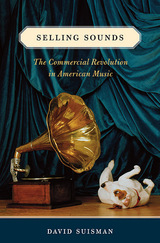
Since the Civil War, the United States military has used music for everything from recruitment and training to signaling and mourning. “Reveille” has roused soldiers in the morning and “Taps” has marked the end of a long day. Soldiers have sung while marching, listened to phonographs and armed forces radio, and filled the seats at large-scale USO shows. Whether the sounds came from brass instruments, weary and homesick singers, or a pair of heavily used earbuds, where there was war, there was music too.
Instrument of War is a first-of-its-kind study of music in the lives of American soldiers. Historian David Suisman traces how the US military used—and continues to use—music to train soldiers and regulate military life, and how soldiers themselves have turned to music to cope with the emotional and psychological traumas of war. Although musical practices have been part of war since time immemorial, the significance of the US military as a musical institution has rarely been recognized. Suisman also reveals a darker history of music, specifically how musical practices have enabled the waging of war. Instrument of War challenges assumptions that music is inherently a beneficent force in the world, demonstrating how deeply music has been entangled in large-scale state violence.
Whether it involves chanting “Sound off!” in basic training, turning on a radio, or listening to a playlist while out on patrol, the sound of music has long resonated in soldiers’ wartime experiences. Now we can finally hear it.

From Tin Pan Alley to grand opera, player-pianos to phonograph records, David Suisman’s Selling Sounds explores the rise of music as big business and the creation of a radically new musical culture. Around the turn of the twentieth century, music entrepreneurs laid the foundation for today’s vast industry, with new products, technologies, and commercial strategies to incorporate music into the daily rhythm of modern life. Popular songs filled the air with a new kind of musical pleasure, phonographs brought opera into the parlor, and celebrity performers like Enrico Caruso captivated the imagination of consumers from coast to coast.
Selling Sounds uncovers the origins of the culture industry in music and chronicles how music ignited an auditory explosion that penetrated all aspects of society. It maps the growth of the music business across the social landscape—in homes, theaters, department stores, schools—and analyzes the effect of this development on everything from copyright law to the sensory environment. While music came to resemble other consumer goods, its distinct properties as sound ensured that its commercial growth and social impact would remain unique.
Today, the music that surrounds us—from iPods to ring tones to Muzak—accompanies us everywhere from airports to grocery stores. The roots of this modern culture lie in the business of popular song, player-pianos, and phonographs of a century ago. Provocative, original, and lucidly written, Selling Sounds reveals the commercial architecture of America’s musical life.
READERS
Browse our collection.
PUBLISHERS
See BiblioVault's publisher services.
STUDENT SERVICES
Files for college accessibility offices.
UChicago Accessibility Resources
home | accessibility | search | about | contact us
BiblioVault ® 2001 - 2024
The University of Chicago Press









